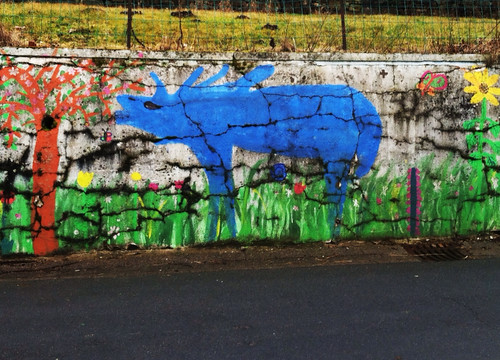Evolution of stegosaur to elk:
Children's mural on retaining wall, Welchershausen, Germany
Oberhausen, Belgium, March 5, 2012—
WE STAYED IN today, for the most part. That's allowed: this game has no rules. I put on my coat at one point and sat outside the front door to clean the mud off my boots. The sky was light grey, as yesterday, and tiny snowflakes occasionally lit on my sleeves. A faint croaking turned my eyes skyward: scores of birds storks perhaps, quite distant and ungainly, flew determinedly north in three huge loose V's. it's cold: I quickly finish the boots and carry them back upstairs to wax them.
Almost irrational, my fondness for these boots, bought four years ago for a trek across the French Alps, worn hundreds of miles, good as new. They treat me very well, so I respond in kind. Sharp rocks, persistent mud, even ankle-deep water don't faze them. Sometimes I think their cruelest assignment is to put up all day with my feet, and I often stuff them with cloth and leave them out overnight for air. Next morning, every morning, they're soft and supple in my hands, embracing and consoling on my feet, ready for another day of it, like a familiar animal, eager to ready me for another day of it.
After a late-lunch pannenkoek — these are among the best, perhaps the best, that I've eaten anywhere — we braved a cold wind to walk a kilometer into Germany, across a one-lane bridge over the fast, narrow ricer Oure, attracted by the promise of a unique museum. Welchenhausen is a tiny town, hardly more than four or five widely separated farmhouses, but its museum, advertised as the world's smallest, is open night and day, seven days a week. It's in a bus shelter, hardly needed for its original purpose since the bus doesn't come any more.
The current show is a series of panels featuring engaging color photos and texts documenting the rebirth of village traditions attached to the calendar: Carnaval and Lent, Easter, May Day, Midsummer day, and so on. The texts and the installation are serious enough to persuade me that this is Anthropology, not merely Tourist Publicity: but of course everything was in German, which I do not read, so I may have been fooled.
I like the Germans, said Mevrouw van Steenbeeck the hotelkeep here yesterday, you have to admire their discipline. I'm sure you're right, I replied, but they seem to enjoy themselves, too. Oh they like to have a good time, she answered. They have their feasts and their holidays. An explanation struck me: They're Catholic, for the most part, no? Yes, she said, and they have their feast days.
Mevrouw van Steenbeeck herself was born and grew up in Amsterdam, and bought this place with her husband thirty-five years ago, having fallen in love with both building and setting at first sight. Let's see: that would have been in 1977. I thought back to the Amsterdam I recall from those days, rather different from today's, and we agreed a little bit about the changes. Her own quarter, for example, was largely destroyed by the building of the huge theater complex at Waterlooplein, where the legendary flea market stood — I bought a wonderful serious raincoat there in 1974 for a mere five guilders, and it served well until a day when it rained in fact, and the coat dissolved into fistfuls of gooey wadding.
As we were finishing our pannekoek this afternoon a fellow came in, looked around as if seeking someone… I told him Mevrouw van Steenbeeck was in the kitchen. (There's only her, today, and her husband, who seems to spend a lot of time reading the newspaper.) Ah so, he said, in German. Late sixties, I'd say, certainly Dutch, slim, rather muscular, balding, with curly white hair on each side. He was the only other person in the dining room tonight — yesterday there had been two other couples.
He smiled at me encouragingly when I got up from table after the soup to stand a few minutes with my kidneys to the fire: I'm too old, I explained, in Dutch, He answered in German, and when I told him I didn't speak German said regretfully his only other language was Dutch — but said that in so thick a Limburgse accent it was very hard to understand. ultimately it began to lock in, or he reverted to the Dutch he'd learned in school.He was a painter, he said; he'd painted the three rather nice landscapes hanging in the dining room. A bit of van Gogh there, I said, in the geometry; I like them.
He smiled in agreement: van Gogh, but not imitative. Painting like this, well done, shows not copying technique but learning from it, to turn it to something useful today. He's having a show of local landscapes in Reuland in April: I'll look for internet mentions. I come here for twenty years, he said, lapsing back into German. Has it changed in those twenty years, I asked; no, not at all.
I asked Mevrouw van Steenbeeck later what his name is. Pierre Houden, she said, pronouncing it in the Limburgse manner, with a French "ou" making me misspell the name. That's now they talk in Roermond, she explained, resignedly. Yes, but "Pierre"? Not Piet? Well, she said, he's an artist, he's entitled. And he's nice, nose not in air.
Tomorrow, cold or not, we leave this wonderful spot foe a walk to Dasbourg. That's life, at least as I live it: find, enjoy, move on no regrets. Take the memories with you.




